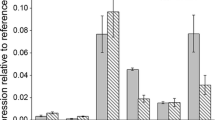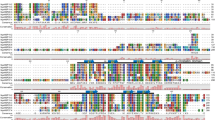Abstract
Light- and dark-adaptation leads to changes in rhabdom morphology and photopigment distribution in the octopus retina. Molecular chaperones, including heat shock proteins (Hsps), may be involved in specific signaling pathways that cause changes in photoreceptor actin- and tubulin-based cytoskeletons and movement of the photopigments, rhodopsin and retinochrome. In this study, we used immunoblotting, in situ RT-PCR, immunofluorescence and confocal microscopy to localize the inducible form of Hsp70 and the larger Hsp90 in light- and dark-adapted and dorsal and ventral halves of adult octopus retinas. The Hsps showed differences in distribution between the light and dark and in dorsal vs. ventral position in the retina. Double labeling confocal microscopy co-localized Hsp70 with actin and tubulin, and Hsp90 with the photopigment, retinochrome. Our results demonstrate the presence of Hsp70 and Hsp90 in otherwise non-stressed light- and dark-adapted octopus retinas. These Hsps may help stabilize the cytoskeleton, important for rhabdom structure, and are perhaps involved in the redistribution of retinochrome in conditions of light and dark.
Similar content being viewed by others
References
Aguilar, L., Yanez, E., Flores, A. & Robles, L. J. (1993) Distribution of three retinal proteins in developing octopus photoreceptors. Journal of Neurocytology 22, 425–435.
Barbe, M. F., Tytell, M., Grower, D. J. & Welch, W. J. (1988) Hyperthermia protects against light damage in the rat retina. Science 241, 1817–1820.
Beasley, T. C., Tytell, M. & Sweatt, A. J. (1997) Heat shock protein 70 in the retina of Xenopus laevis, in vivo and in vitro: Effect of metabolic stress. Cell and Tissue Research 290, 525–538.
Bloch, M. A. & Johnson, K. A. (1995) Identification of a molecular chaperone in the eucaryotic flagellum and its localization to the site of microtubule assembly. Journal of Cell Science 108, 3541–3545.
Breneman, J. W., Robles, L. J. & Bok, D. (1986) Lightactivated retinoid transport in cephalopod photoreceptors. Experimental Eye Research 42, 645–658.
Burston, S. G. & Clark, A. R. (1995) Molecular chaperones: Physical and mechanistic properties. Essays in Biochemistry 29, 125–136.
Cohen, A. I. (1973) An ultrastructural analysis of the photoreceptors of the squid and their synaptic connections. I. Photoreceptive and non-synaptic regions of the retina. Journal of Comparative Neurology 147, 351–378.
Csermely, P., Schnaider, T., Soti, C., Prohaszka, Z. & Nardai, G. (1998) The 90-kDa molecular chaperone family: Structure, function and clinical applications. A comprehensive review. Pharmacology and Therapeutics 79, 129–168.
Czar, M. J., Welsh, M. J. & Pratt, W. B. (1996) Immunofluorescence localization of the 90-kDa heat-shock protein to cytoskeleton. European Journal of Cell Biology 70, 322–330.
Dean, D. O., Kent, C. R. & Tytell, M. (1999) Constitutive and inducible heat shock protein 70 immunoreactivity in the normal rat eye. Investigative Ophthalmology and Visual Science 40, 2952–2962.
Dean, D. O. & Tytell, M. (2001) Hsp25 and-90 immunoreactivity in the normal rat eye. Investigative Ophthalmology and Visual Science 42, 3031–3040.
de Velasco, B., Martinez, J. M., Ochoa, G. H., Miller, A. M., Clark, Y. M., Matsumoto, B. & Robles, L. J. (1999) Identification and immunolocalization of actin cytoskeletal components in light-and dark-adapted octopus retinas. Experimental Eye Research 68, 725–737.
D'Souza, C. A., Rush, S. J. & Brown, I. R. (1998) Effect of hyperthermia on the transcription rate of heat-shock genes in the rabbit cerebellum and retina assayed by nuclear run-ons. Journal of Neuroscience Research 52, 538–548.
Fink, A. L. (1998) The Hsp70 reaction cycle and its role in protein folding. In Molecular Chaperones in the Life Cycle of Proteins: Structure, Function and Mode of Action (edited by Fink, A. L. & Goto, Y.) pp. 123–150. New York: Marcel Dekker, Inc.
Fostinis, Y., Theodoropoulos, P. A., Gravanis, A. & Stournaras, C. (1992) Heat shock protein HSP90 and its association with the cytoskeleton: A morphological study. Biochimie et Biologie Cellulaire 70, 779–786.
Freeman, B. C. & Morimoto, R. I. (1996) The human cytosolic molecular chaperones hsp90, hsp70 (hsc70) and hdj-1 have distinct roles in recognition of a nonnative protein and protein refolding. EMBO Journal 15, 2969–2979.
Garnier, C., Barbier, P., Gilli, R., Lopez, C., Peyrot, V. & Briand, C. (1998) Heat-shock protein90 (hsp90) binds in vitro to tubulin dimer and inhibits microtubule formation. Biochemical and Biophysical Research Communications 250, 414–419.
Ham, W. T., Ruffolo, J. J. Jr., Mueller, H. A. & Clarke A. M. (1978) Histologic analysis of photochemical lesions produced in rhesus retina by shortwavelength light. Investigative Ophthalmology and Visual Science 17, 1029–1035.
Hara, T. & Hara, R. (1991) Retinal-binding protein: Function in chromophore exchange system in the squid visual cell. Progress in Retinal Research 10, 179–206.
Hendrick, J. P. & Hartl, F. U. (1993) Molecular chaperone functions of heat shock proteins. Annual Review of Biochemistry 62, 349–384.
Jakob, U. & Buchner, J. (1994) Assisting spontaneity: The role of hsp90 and small hsps as molecular chaperones. Trends in Biochemical Sciences 19, 205–211.
Kato, S., Akagi, T., Sugimura, K., Kishida, A. & Akashi, M. (1998) Evaluation of biological responses to polymeric biomaterials by RT-PCR analysis III: Study of HSP70, 90 and 47 mRNA expression. Biomaterials 19, 821–827.
Kojima, M., Hoshimaru, M., Aoki, T., Takahashi, J. B., Ohtsuka, T., Asahi, M., Matsuura, N. & Kikuchi, H. (1996) Expression of heat shock proteins in the developing rat retina. Neuroscience Letters 205, 215–217.
Laemmli, U. K. (1970) Cleavage of structural proteins during the assembly of the head of bacteriophage T4. Nature 227, 680–685.
Liang, P. & Macrae, T. H. (1997) Molecular chaperones and the cytoskeleton. Journal of Cell Science 110, 1431–1440.
Martinez, J. M., Elfarissi, H., de Velasco, B., Ochoa, G. H., Miller, A. M., Clark, Y. M., Matsumoto, B. & Robles, L. J. (2000) Distribution of tubulin, kinesin and dynein in light-and dark-adapted octopus retinas. Visual Neuroscience 17, 127–138.
Masing, T. E., Rush, S. J. & Brown, I. R. (1990) Induction of a heat shock gene (hsp70) in rabbit retinal ganglion cells detected by in situ hybridization with plasticembedded tissue. Neurochemical Research 15, 1229–1235.
Molina, T. M., Torres, S. C., Flores, A., Hara, T., Hara, R. & Robles, L. J. (1992) Immunocytochemical localization of retinal binding protein in the octopus retina: A shuttle protein for 11-cis retinal. Experimental Eye Research 54, 83–90.
Morales, A. V., Hadjiargyrou, M., Diaz, B., Hernandez-Sanchez, C., de Pablo, F. & de la Rosa, E. J. (1998) Heat shock proteins in retinas neurogenesis: Identification of the PM1 antigen as the chick Hsc70 and its expression in comparison to that of other chaperones. European Journal of Neuroscience 10, 3237–3245.
Noell, W. K., Walker, V. S., Kang, B. S. & Berman, S. (1966) Retinal damage by light in rats. Investigative Ophthalmology 5, 450–473.
Ochoa, G. H., Clark, Y. M. & Robles, L. J. (2000) Localization of hsp70 and hsp90 in light-and dark-adapted octopus photoreceptors. Investigative Ophthalmology and Visual Science 41, S594.
O'Malley, K., Mauron, A., Barchas, J. D. & Kedes, L. (1985) Constitutively expressed rat mRNA encoding a 70-kilodalton heat-shock-like protein. Molecular Cell Biology 5, 3476–3483.
Redmond, T., Sanchez, E. R., Bresnick, E. H., Schlesinger, M. J., Toft, D. O., Pratt, W. B. & Welsh, M. J. (1989) Immunofluorescence colocalization of the 90-kDa heat-shock protein and microtubules in interphaseandmitoticmammaliancells. European Journal of Cell Biology 50, 66–75.
Robles, L. J., Cabebe, C. S., Aguilo, J. A., Anyakora, P. A. & Bok, D. (1984) Autoradiographic and biochemical analysis of photoreceptor membrane renewal in octopus retina. Journal of Neurocytology 13, 145–164.
Robles, L. J., Camacho, J. L., Torres, S. C., Flores, A., Fariss, R. N. & Matsumoto, B. (1995) Retinoid cycling proteins redistribute in light-/dark-adapted octopus retinas. Journal of Comparative Neurology 358, 605–614.
Robles, L. J., Clark, Y. M., Mendoza, J., Ramirez, T. & Rivas, F. (2001) Localization and expression of myosin III in light-and dark-adapted octopus retinas. Investigative Ophthalmology and Visual Science 42, S365.
Robles, L. J., Watanabe, A., Kremer, N. E., Wong, F. & Bok, D. (1987) Immunocytochemical localization of photopigments in cephalopod retinae. Journal of Neurocytology 16, 403–415.
Sanchez, C., Padilla, R., Paciucci, R., Zabala, J. C. & Avila, J. (1994) Binding of heat shock protein 70 (hsp70) to tubulin. Archives of Biochemistry and Biophysics 310, 428–432.
Sanchez, E. R., Redmond, T., Scherrer, L. C., Bresnick, E. H., Welsh, M. J. & Pratt, W. B. (1988) Evidence that the 90-kilodalton heat shock protein is associated with tubulin-containing complexes in L cell cytosol and in intact PtK cells. Molecular Endocrinology 2, 756–760.
Schlesinger, M. J. (1990) Heat shock proteins. Journal of Biological Chemistry 265, 12111–12114.
Shahinfar, S., Edward, D. P. & Tso, M. O. (1991) A pathologic study of photoreceptor cell death in retinal photic injury. Current Eye Research 10, 47–59.
Tanaka, Y., Kobayashi, K., Kita, M., Kinoshita, S. & Imanishi, J. (1995) MessengerRNAexpression of heat shock proteins (HSPs) during ocular development. Current Eye Research 14, 1125–1133.
Torres, S. C., Camacho, J. L., Matsumoto, B., Kuramoto, R. T. & Robles, L. J. (1997) Light-/dark-induced changes in rhabdom structure in the retina of Octopus bimaculoides. Cell and Tissue Research 290, 167–174.
Tytell, M., Barbe, M. F. & Brown, I. R. (1994) Induction of heat shock (stress) protein 70 and its mRNA in the normal and light-damaged rat retina after whole body hyperthermia. Journal of Neuroscience Research 38, 19–31.
Ungewickell, E. (1985) The 70-Kd mammalian heat shock proteins are structurally and functionally related to the uncoating protein that releases clathrin triskelia from coated vesicles. EMBO Journal 4, 3385–3391.
van der Straten, A., Rommel, C., Dickson, B. & Hafen, E. (1997) The heat shock protein 83 (Hsp83) is required for Raf-mediated signaling in Drosophila. EMBO Journal 16, 1961–1969.
Wells, M. J. (1978) An inventory of the sense organs. In Octopus: Physiology and Behaviour of an Advanced Invertebrate. pp. 141–177. New York: Halsted Press.
Williams, T. P. & Howell, W. L. (1983) Action spectrum of retinal light-damage in albino rats. Investigative Ophthalmology and Visual Science 24, 285–287.
Yahara, I. (1998) Structure and function of the 90-kDa stress protein hsp90. In Molecular Chaperones in the Life Cycle of Proteins: Structure, Function and Mode of Action (edited by Fink, A. L. & Goto, Y.) pp. 183–192. New York: Marcel Dekker, Inc.
Yamada, E. & Usukura, J. (1982) The plasmalemma specialization of retinal cells in the cuttlefish as revealed by freeze-fracture method. In The Structure of the Eye (edited by Hollyfield, J. G.) pp. 25–34. New York: Elsevier North Holland.
Yamaguchi, K., Gaur, V. P., Tytell, M., Hollman, C. R. & Turner, J. E. (1991) Ocular distribution of 70-kDa heat-shock protein in rats with normal and dystrophic retinas. Cell and Tissue Research 264, 497–506.
Yamamoto, T., Tasaki, K., Sugawara, Y. & Tonosaki, A. (1965) Fine structure of the octopus retina. Journal of Cell Biology 25, 345–359.
Zuniga, F. I., Clark, Y. M., Ochoa, G. H., Robles, L. J. (2002) Identification of actin-binding proteins in light-/dark-adapted octopus retinas. Molecular Biology of the Cell 13, 36a.
Author information
Authors and Affiliations
Rights and permissions
About this article
Cite this article
Ochoa, G.H., Clark, Y.M., Matsumoto, B. et al. Heat shock protein 70 and heat shock protein 90 expression in light- and dark-adapted adult octopus retinas. J Neurocytol 31, 161–174 (2002). https://doi.org/10.1023/A:1023949707669
Issue Date:
DOI: https://doi.org/10.1023/A:1023949707669




